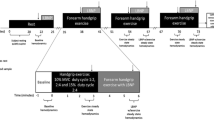Abstract
There is controversy over whether isometric contraction of the forearm evokes vasoconstriction or vasodilatation in the muscles of the contralateral forearm. In the present study we have investigated in normal man, the effects of isometric contraction of one arm at 75, 50 and 25% maximum voluntary contraction (MVC) on arterial pressure, heart rate, blood flow and vascular resistance of the contralateral forearm and on electromyographic (EMG) activity recorded from that same arm with sensitive, surface electrodes.
When EMG activity was not being recorded from the ‘resting’ arm, isometric contraction of the contralateral arm for 2 min evoked increases in arterial pressure and heart rate whose magnitudes were graded with % MVC and an increase in forearm blood flow and a decrease in forearm vascular resistance at 75, 50 and 25% MVC, indicating vasodilatation. Further experiments in which EMG activity was recorded from the ‘resting’ arm demonstrated that the decrease in forearm vascular resistance evoked by 75% MVC was associated with a substantial increase in EMG activity of the extensor and flexor muscles of that arm. By contrast, when forearm contraction was performed at 75% MVC whilst subjects viewed the EMG activity in the ‘resting’ arm on an oscilloscope and kept EMG activity minimal, vascular resistance increased in that arm, indicating vasoconstriction. Further, when subjects performed contraction at 25% MVC whilst showing minimal EMG activity in the contralateral arm, vascular resistance in that same arm increased (from 78 ± 16 to 124 ± 29 mmHg/ml/min/100 ml tissue). These results are discussed in relation to those of previous studies. We propose, that in normal man, isometric contraction of the forearm evokes primary vasoconstriction in the muscles of the contralateral forearm, but that this response may be overcome by muscle vasodilatation occurring secondary to unintended muscle contraction or as part of the alerting response to acute stress.
Similar content being viewed by others
References
Lind AR. Cardiovascular adjustments to isometric contraction: static effect. In: Shepherd JT, Abboud FM, eds.Handbook of Physiology, Section 2 Vol II, pt 2. Bethesda, MD: Am Phys Soc, 1983: 916–947.
Cotzias C, Marshall JM. Differential effects of isometric exercise on the cutaneous circulation of different regions.Clin Auton Res 1992;2: 235–241.
Lind AR, Taylor SH, Humphreys PW, Kennelly BM, Donald KW. Circulatory effects of sustained voluntary muscle contraction.Clin Sci 1964;27: 229–244.
Lind AR, Dahms TE, Williams CA, Petrosky JS. The blood flow through the ‘resting’ arm during hand-grip contractions.Circ Res 1981;48 (Suppl I): 104–109.
Eklund B, Kaijser L, Knutsson E. Blood flow in resting (contralateral) arm and leg during isometric contraction.J Physiol 1974;240: 111–124.
Eklund B, Kaijser L. Effect of regionalα- andβ-adrenergic blockade on blood flow in the resting forearm during contralateral isometric hand grip.J Physiol 1976;262: 39–50.
Rusch NJ, Shepherd JT, Webb RC, Vanhoutte PM. Differential behaviour of resistance vessels of human calf and forearm during contralateral isometric exercise, mental stress and abnormal respiratory movements.Cir Res 1981;48 (Suppl I): 118–130.
Hilton SM. The defence-arousal system and its relevance for circulatory and respiratory control.J Exp Biol 1982;100: 159–174.
Johnson SW, Lynn PA, Miller S, Reed GAL. A skin-mounted pre-amplifier for recording the surface electromyogram.J Physiol 1977;269: 16P.
Cotzias C, Marshall JM. Vascular responses evoked by isometric hand-grip in the contralateral forearm of human subjects.J Physiol 1991;438: 93P.
Whitney RJ. The measurement of volume changes in human limbs.J Physiol 1953;121: 1–27.
Holling HE, Boland HC, Russ E. Investigation of arterial obstruction using a mercury-in-rubber strain gauge.Am Heart J 1962;62: 194–205.
Duprez DA, Essandoh LK, Vanhoutte PM, Shepherd JT. Vascular responses in forearm and calf to contralateral static exercises.J Appl Physiol 1989;66: 669–674.
Saito M, Naito M, Mano T. Different responses in skin and muscle sympathetic nerve activity to static muscle contraction.J Appl Physiol 1990;69: 2085–2090.
Seals DR. Sympathetic neural discharge and vascular resistance during exercise in humans.J Appl Physiol 1989;66: 2472–2478.
Marshall JM, Tandon HC. Direct observations of muscle arterioles and venules following contraction of skeletal muscle fibres in the rat.J Physiol 1984;350: 447–459.
Delius W, Hagbarth A, Hongell A, Wallin BG. Manoeuvres affecting sympathetic outflow in human muscle nerves.Acta Physiol Scand 1972;84: 82–94.
Kozlowsky S, Brzezinska Z, Nazar K, Kowalski W, Franczyk M. Plasma catecholamines during sustained isometric exercise.Clin Sci 1973;45: 723–731.
Viveros OH, Garlick DG, Renkin EM. Sympathetic beta adrenergic vasodilatation in skeletal muscle of the dog.Am J Physiol 1968;215: 1218–1225.
Brick I, Hutchinson KJ, Roddie IC. The effect of beta-adrenergic receptor blockade on the vasodilator response in the forearm to voluntary hyperventilation.J Physiol 1966;187: 645–649.
Barcroft H, Brod J, Hejl Z, Hirzjarvic EA, Kitchin AH. The mechanism of the vasodilatation in the forearm muscle during stress (mental arithmetic).Clin Sci 1960;19: 577–586.
Mark AL, Victor RG, Herhed C, Wallin BG. Microneurographic studies of the mechanisms of sympathetic nerve responses to static exercise in humans.Cir Res 1985;57: 461–469.
Goodwin GM, McCloskey PI, Mitchell JH. Cardiovascular and respiratory responses to changes in central command during isometric exercise at constant muscle tension.J Physiol 1972;226: 173–190.
Mitchell JH, Schibye B, Payne FC, Altin B. Response of arterial pressure to static exercise in relation to muscle mass, force development and electromyographic activity.Circ Res 1981;48 (Suppl I): 70–75.
Dean C, Coote JH. Discharge patterns in postganglionic neurones to skeletal muscle and kidney during activation of the hypothalamic and midbrain defence areas in the cat.Brain Res 1986;377: 271–278.
Author information
Authors and Affiliations
Rights and permissions
About this article
Cite this article
Cotzias, C., Marshall, J.M. Vascular and electromyographic responses evoked in forearm muscle by isometric contraction of the contralateral forearm. Clinical Autonomic Research 3, 21–30 (1993). https://doi.org/10.1007/BF01819139
Received:
Accepted:
Issue Date:
DOI: https://doi.org/10.1007/BF01819139




